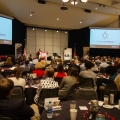Overcoming the Staff Meeting Rut
Have you ever sat in a weekly staff meeting, listening to a colleague read their to-do list, wondering what you should fix for dinner? Or, worse, have you ever LED a staff meeting and witnessed someone falling asleep? I have.
A few months ago, our staff meetings consistently ran over the allotted hour. But, facing the decision to either condense them or – gulp – add time, I found myself wondering why we even had staff meetings. We would go around the room, and each person would talk about their weekly priorities. In theory, this was logical. In practice, it was painful.
I asked other staff members what they thought about the staff meetings, and it turned out that EVERYONE felt the same way: a lot of time, but little value.
The honest feedback:
- They felt pressure to present something on their turn, even if they were working on the same long-term projects they shared last week.
- Sometimes, a staff member was looking for input or feedback, but there was never time for anything meaningful.
- At the same time, I had important updates from others in the division, and we often didn’t get to them.
However, all agreed that time together as a team is valuable. There was a hunger for the opportunity to provide meaningful input and feedback.
New format for staff meeting:
We keep it simple:
- Announcements
- “Deep Dive” topics (each 10 – 45 minutes)
- Celebrations: Kudos, SIC’EM stickers, and wrapping up projects/campaigns
The deep dive topics rotate, and different team members present and/or lead conversations. Here are some “deep dive” topics from recent staff meetings:
- The writers on the team taught everyone about the mysteries of tracked changes in Microsoft Word.
- DARCOMMers working on Bulldog 100 presented their announcement plan to get initial feedback before taking it to the alumni team.
- We reviewed Donor Relation’s fall projects to prepare for a planning meeting; those who don’t work directly with DRS looked for ‘dot-connecting’ opportunities.
- We aligned on the communication plans for the launch of the UGA Mentor Program.
Here’s the catch: it takes a little planning. However, it’s not more than 5-10 minutes, and the hour-long staff meeting has become incredibly engaging and productive.
So what?
Am I suggesting everyone change their staff meeting format? No. Sharing weekly priorities is a common format and can be valuable. What I wish I’d done earlier was talking to my teammates about their perspective on how we should use that time. They had great feedback and even better ideas.
If you’re in a staff meeting rut, don’t be afraid to shake it up. Ask co-workers what they think. Decide what you need to get out of it. And most importantly: listen.





